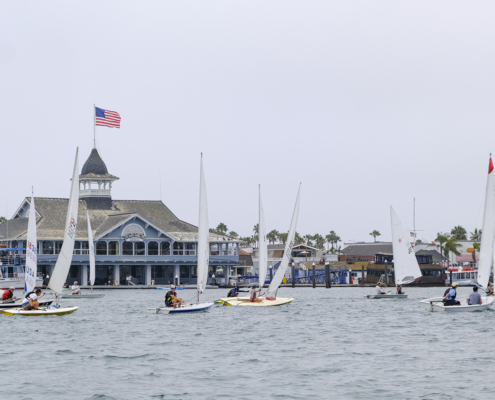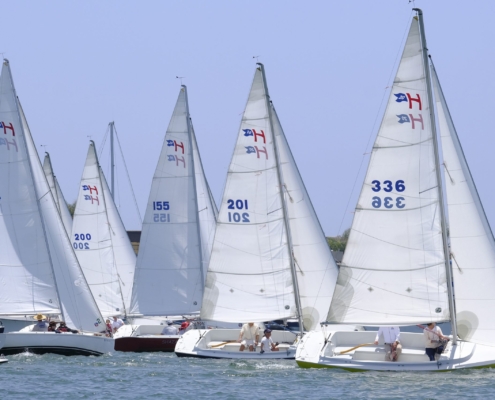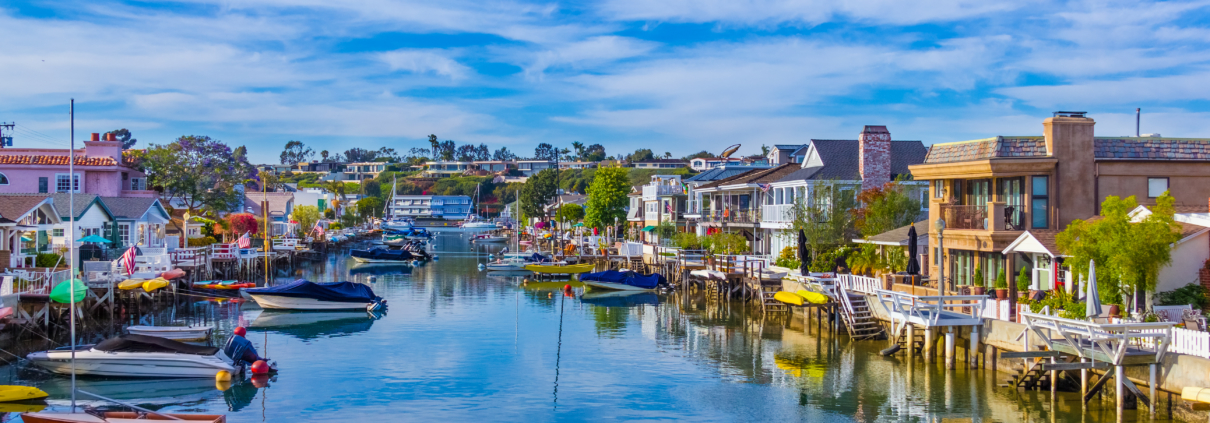The Commodores Club Presents the 87th Annual Flight of Newport Beach July 16
By Christopher Trela – July 07, 2023
Source: Newport Beach Independent The Commodores Club Presents the 87th Annual Flight of Newport Beach July 16
If you’re out and about on Newport Harbor on Sunday afternoon, July 16, you may see dozens of sailboats racing around the harbor. Give them plenty of room and cheer them on—it’s the 87th Annual Flight of Newport Beach, presented by the Commodores Club of the Newport Beach Chamber of Commerce with assistance from the Balboa Yacht Club.
The race dates back to 1936 when it was known as the Flight of the Snowbirds—a small wooden sailboat that was once the most popular boat in the harbor (and was used in the Olympic Games). Some 200 boats regularly entered the race in the 1950s.

The 2022 Flight of Newport Beach / photo by Jim Collins
In the early 1970s the race briefly became Flight of the Kites, a sailing dinghy slightly longer than a Snowbird.
The race was renamed again in 2020 to The Flight of Newport and welcomed ILCA (formerly known as Lasers), Harbor 20 and Terra RS boats.
The Flight of Newport has three separate races depending on class, and three start times on July 16. The RS Terra boats set sail from the Balboa Pavilion at 12:45 p.m., the ILCA 7 and 6 (Laser Full and Radial) at 1 p.m., and Harbor 20 boats at 1:15 p.m.
The boats will take about 90 minutes to complete the course, which circumvents the entire bay.
According to information from race officials, the first-place winner in the ILCA fleet will receive the Albert Soiland Trophy, named after the first Commodore of the Newport Harbor Yacht Club along with a new sail provided by West Coast Sailing.
Other placing racers first to cross the finish line in these categories will also receive prizes: ILCA fleet, the First Girl, Youngest Boy, Youngest Girl, Oldest Person and First Married Couple.

The 2022 Flight of Newport Beach / photo by Jim Collins
The Albert Soiland Trophy is engraved with the names of past winners; the trophy has frequently been awarded to sailors who have gone on to participate in bigger races, including the America’s Cup.
“It’s great to see the huge spread in age of the skippers in this race, from young kids to legends of the bay like Seymour Beek and Dave Tingler. The Flight of Newport has been the starting point for many young kids,” said Brett Hemphill, a Commodore and Co-Chair of the Flight of Newport.
There is no charge to enter the race. Each registered participant will receive a Flight of Newport T-shirt and must provide their own boat.
For more information including sailing instructions and to register for the race, visit https://flightofnewportbeach.com.
By Christopher Trela – July 07, 2023
Source: Newport Beach Independent The Commodores Club Presents the 87th Annual Flight of Newport Beach July 16
Share this entry
By Phillip Palmer
ABC Eyewitness News, Los Angeles
NEWPORT BEACH, Calif. (KABC) — Keeping garbage out of the ocean isn’t easy. So enter Mr. Trash Wheel, the 70-square-foot barge gobbling up garbage by the ton to keep the beach and ocean pristine.
Trash in the streets ends up in the river and then from the river, the ocean.
Hoping to reduce the amount of trash making it to the ocean, Newport Beach is set to become the first west coast city to use a water wheel system to scoop up trash headed toward Upper Newport Bay.
“We really need to knock that trash load down. This is not going to be a silver bullet, it’s not going to get everything, but it’s going to get a big slug of stuff,” said John Kappeler, a senior engineer for the city of Newport Beach.
By Matt Morrison
For a generation of youngsters who grew up around the Newport Harbor, there’s a legacy to perpetuate. OK, maybe they’re only considered youngsters on a geologic scale, yet together they’ve accumulated decades of passion for the fabulous waterway central to our community. The goal now is to preserve it for generations to come.
We might compare it to fixing up a stately landmark home; the curb appeal is still magnificent but the bones need attention. Dennis Durgan can certainly relate to the analogy.
A residential real estate professional in the community for more than four decades, Durgan grew up on the harbor, beginning in the early 1960’s when it was a seasonal recreation destination. He learned to sail here, then went on to crew in three America’s Cup competitions working with both Ted Turner and Dennis Connor. Now it’s a cause for the future, and not just his own.
“There are numerous issues the harbor has, and will continue to have, as we move forward. There’s more and more people that want to use it,” Durgan explains. “I used to call it the sandbox. Well, the sandbox is overflowing with kids that want to play.”
“With all of their toys…” chimes in Val Lyon, like Durgan, a board member of the Newport Harbor Foundation, established in 2019.





Leave a Reply
Want to join the discussion?Feel free to contribute!